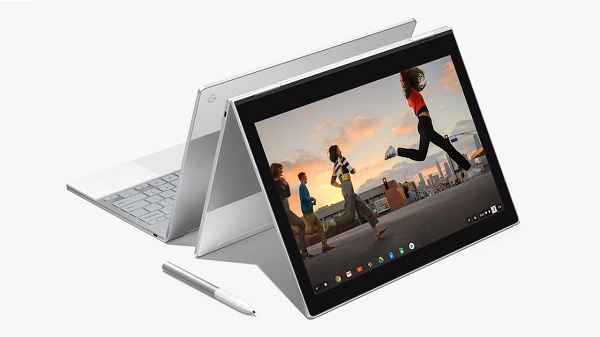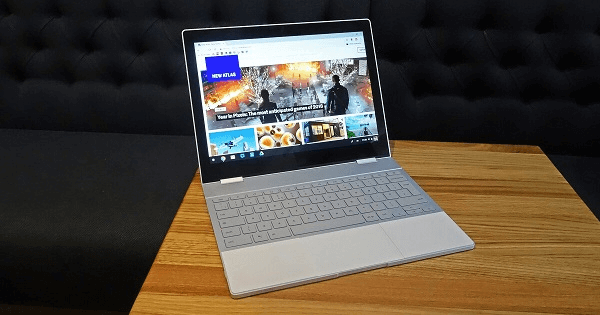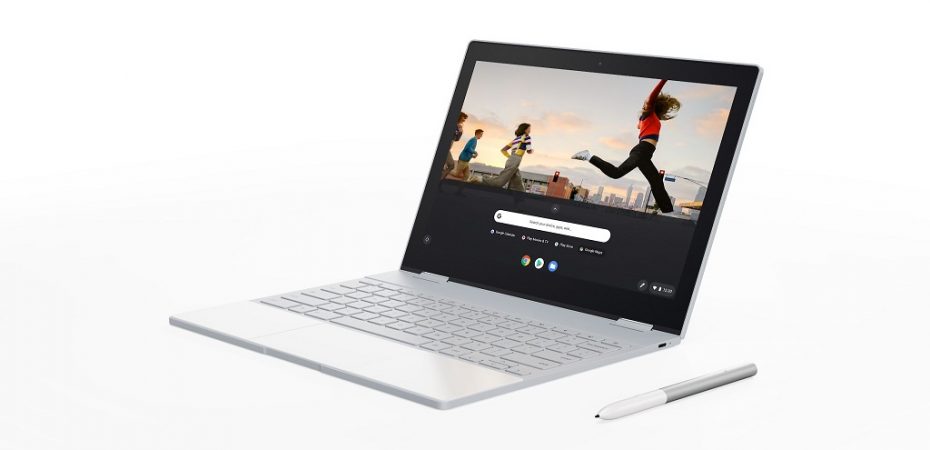Google has made a phenomenal entry into the laptop industry, especially the Chromebook category, with the release of PixelBook. Originally launched in 2017, the laptop didn’t get much appreciation from users in the early days. However, with the two-in-one hybrid model, the Google PixelBook boasts terrific machinery that places it at the top of the Chromebook lineup.
Despite operating on the same Chrome OS, PixelBook is priced higher than its competitors, including HP’s Chromebook 13 and Samsung’s Chromebook Pro. Whether you need it for standard day-to-day usage or professional work, Google PixelBook 12 fits your needs perfectly.
Everything is tested and tried to the limits, from its two-in-one hybrid design and PixelBook Pen to extraordinary hardware specs and Chrome OS. When it comes to features, there is a lot to unveil in this Google Pixelbook review, so stay tuned till the end.
Elegant Design Statement

Before we delve into the extraordinary hardware specs, let’s talk about the flawless design. With the 3:2 aspect ratio of the screen enclosed in a sleek aluminum body, PixelBook i7 is probably the finest ergonomically designed computer by Google.
The aluminum unibody coupled with silicone padding at the right spots sets a class of its own. The super-slim laptop measures slightly above 10mm in thickness and weighs remarkably below the 2.5 pounds mark. This makes it lighter and thinner than Samsung Chromebook Pro and Asus Chromebook Flip.
The minimalist laptop resembles aesthetically pleasing notebooks you’d normally find in boutique stationery stores. The convertible folding design into a tablet remains the striking feature of the laptop. Want to read your book before bed? Flip the keyboard back and use it as a tablet for hassle-free reading.
The backlit keyboard takes the aesthetics one step further, not to mention it allows you to work at night. The keys are quiet and smooth, keeping the disturbance level to an absolute minimum. Moreover, the silicone wrist pads keep your hands and palms rested, making it a must-have device for writers. If you have used an iPad Pro or MacBook, the keys would feel just the same, if not better.
There is a chance you might feel the keyboard is slightly different because there are keys you’d find in standard laptops. Instead of a caps lock on the left side, the laptop features a direct search key for google search. There are some additional keys as well for added assistance for easy usage.
Chrome OS – A Breakthrough

Although Chrome OS was an unproven technology at its initial launch and received quite a backlash in the days, times have changed. The operating system that could only be used with Wi-Fi and relied on the Chrome web store has improved drastically.
The latest OS version features Google Play, which allows you to download Android applications, just like your normal phone or tablet. Not only can you run applications like Microsoft Office and password managers, but you can also run social media apps like Instagram. However, improvements are still needed to make android apps be more Chrome OS friendly.
Most apps can resize like a regular window offering the same dimension as they do with the phone. However, most apps are displayed as moveable windows and enable full-screen mode when the laptop converts in tablet form (which may not work for most people).
The new Chrome OS updates allow you to operate web apps and save web pages. First, the webpages are saved as a separate window that displays like an app instead of opening up on the browser as a new tab. Moreover, you can obtain data or content from Google Drive, save data in a file system, and split the window screen into laptop mode. The Chrome OS receives updates for security and OS at a 6-week interval to save the day.
Nevertheless, a major portion of the recent updates and technology remains focused around the chrome web browser. Although it would be foolish to assume Chrome OS is on par with Windows and macOS in terms of offline functionality, Chrome OS takes the lead for high web browsing power. This means you can open and run as many web pages or tabs as you want without experiencing slowness or lag. This makes it no less than a supercomputer when running multiple web apps simultaneously.
Google has gone above and beyond to improve the Chrome OS’s user experience. Apart from the interactive display factor that presents web and android applications differently, you will also find a google search bar at the top end for a quick search. What makes it even better is that you can make both on-device and web searches on the same search bar. Isn’t that Convenient!
Enhanced Assistance with PixelBook Pen and Google Assistant

Another prominent feature – or as most people would say – an option, is the PixelBook Pen. The $99 exclusive price for the pen on top of the PixelBook, is somewhat outrageous. But Apple has been doing it for ages; besides, PixelBook has already received enough backlash.
Considering it allows you to take notes, draw, and enable google assistant, the $99 active stylus seems worth the price, given you have that much to spare. The plus points of the PixelBook Pen include;
- 10ms response time
- AAAA batteries
- Angle Detection up to 60-degrees
- 2,000 levels of pressure sensitivity
The stylus was designed in collaboration with Wacom, which makes it sensitive to more than 2000 levels of pressure.
On the lookout, everything is phenomenal about the pen, at least in terms of hardware. However, hardware needs equally efficient software to function properly. The pen seems to perform better with minimal or undetectable lag on apps that support Google’s updated APIs. The lag is real and downright atrocious when it comes to apps that aren’t updated to the latest google code.
The pen has 60-degree angle awareness and less than 10ms of latency, enhancing usability and removing lag in the process. Unlike Apple’s pencil, the PixelBook Pen saves you from the hassle of plugging and recharging time after time. It comes with AAAA batteries with sufficient charging back up to last a year.
The PixelBook Pen comes with a google assistant button to quickly search for anything you have selected. The trick is to press the button and circle anything on the screen with the stylus. The google assistant analyzes the circled content to find what you have asked for.
Besides, calling for google assistant on PixelBook couldn’t be any simpler. The laptop has a dedicated Google Assistant Button right in the middle of ‘alt key’ and ‘Cntrl key’ at the bottom left corner of the keypad. A google assistant pop-up window will appear as soon as you press the button, allowing you to make a quick and easy search.
Regardless, the PixelBook pen has little use unless you are a student, market analyst, designer, and an avid reader. The pen isn’t attachable with the PixelBook, making it easier to lose or keep track of. Besides, the AAAA batteries are hard to find at local stores, leaving you no option but to source them online.
Hardware Specs
The Google PixelBook lands with some serious hardware specs you’d see in a Chromebook so far. Unlike other Chromebook models that usually come with a 16GB or 32GB drive space, the PixelBook poses serious competition, with its base variant offering 128GB of storage space.
Other PixelBook variants range up to 512GB NVMe, enabling users with sufficient space for saving files and downloading apps. Let’s have a quick walk around on PixelBook specifications:
- 7th-Gen Intel Core i5, i7 processor
- 8GB, 16GB of RAM
- 128GB SSD, 256GB SSD, and 512GB NVMe
- 720p front-facing camera
- Bluetooth 4.2
The high-tech numbers seem overkill compared to other Chromebooks. The Intel processors used in PixelBook have Y series chips that feature low power consumption and heat dissipation. And that is what makes the thin PixelBook fanless.
Another feature that’s helped shrink the laptop size is the installation of USB-C ports instead of typical slots. Regardless of the two USB-C ports, the laptop does not come with USB-C – USB-A adapter. So, if you want to connect your USB-A devices or peripherals with your laptop, make sure to get an adapter first.
The 12.3-inch touchscreen with a 3:2 aspect ratio offers a dynamic display unless the bezels are too big for you. Considering its thinness, the bigger bezels seem justified; however, other companies have also introduced smaller bezels.
Smart Performance

With its lightweight and thin design, the PixelBook gives a premium finish. With high-end specs, the Google PixelBook performs just like you’d expect from a 1000-dollar machine with high-end specs. No matter how many apps are running in the background simultaneously or the number of open tabs, the computer sails smoothly and effortlessly.
The e PixelBook i7 exhibited a 7,927 score on the Geekbench 4 performance check. Although the score is impressive, it is still lower than the likes of Lenovo Yoga 920 and iPad Pro. Nevertheless, the high-performing laptop left its competitors to dust by scoring 145 on the JetStream JavaScript standards.
The Google PixelBook features an Intel HD 615 graphics chip that backs the masterclass visuals on the screen. The chip rendered 2,000 fish at 60 frames per second on the WebGL Aquarium test leaving behind Samsung Chromebook Pro and the Asus Chromebook Flip.
Coming to battery life, the PixelBook leads the game once again. Well, that’s a given, considering the Google PixelBook i7 is not your average Chromebook. While Google claims 10 hours of run time, the actual time can be slightly off. Still, you would comfortably achieve 8 to 9 hours of battery life in spite of rigorous usage. The heat management in the book is amazing as well. Even though no fans are installed, the laptop remains calm and cool throughout.
Price Point
Although Chromebooks are known for their cost-effectiveness, Google PixelBook is an exception. Starting at $999 for the i5 base variant and climbing up to $1,649 for the top-of-the-line model, Google PixelBook sits in the premium lineup.
Not to mention, there is another $99 premium for the PixelBook Pen. It’s significantly expensive, no doubt, but you don’t have to buy the pen unless it’s fundamental to your work. The sleek premium design, updated Chrome OS, generous hardware specs, and streamlined performance make the laptop worth every penny. Besides, Intel’s processor is a Y series chip offering refined performance with minimal heat dissipation.
If the price point seems high for your budget, Samsung Chromebook Pro and Asus Chromebook Flip can be a better bargain for your budget. Nevertheless, the Google PixelBook still stands out as a futuristic and tech-savvy product.
The Google PixelBook has been launched in the US, Europe, and some parts of the Middle East. Unfortunately, you might import the device from the US or other states in Australia. There is no clear clarification as to when the PixelBook will hit the Aussie markets.
| Positives | Negatives |
| Aesthetical foldable design, thin and lightweight | No split-screen. |
| Powerful hardware specs ensure better performance. | PixelBook comes separately for a $99 premium. |
| PixelBook Pen and Google Assistant keys | Android apps must be updated to the latest version for Pen compatibility. |
| Updated Version of Chrome OS |
Editor’s Opinion
If you are looking for a super-thin and lightweight without compromising on the hardware specifications or performance, Google PixelBook is the one you need. The two-in-one convertible design enhances the aesthetics multifold. The updated Chrome OS version is streamlined and fast for online web pages and downloaded apps.
The laptop comes in three different variants ranging from $999 to $1,649, making it slightly more expensive than other Chromebooks in the market. If you are a market analyst or designer by profession, the PixelBook Pen can come in quite handy. However, the pen comes at an additional $99, so set your budget accordingly. If high prices and compromised battery life are no problem for you, PixelBook can be a good purchase.
Google Pixelbook Alternatives
The Reviewsed family was upset about the price; we believe that there are better options available.
According to reviews, most of the often listed alternatives cost more than the Pixelbook.
Then there’s performance (despite greater specs on paper) and build quality (except that they are considerably more expensive MacBook Pro).
Google Pixelbook vs. MacBook Pro
For me, the 13-inch MacBook Pro was the logical Pixelbook substitute. I didn’t buy it for several reasons:
It’s incredibly expensive, and I didn’t want to spend that much money;
It’s overdue for an upgrade, so purchasing now makes little sense; I’m not too fond of the new butterfly keyboards. I know a few people that adore them, but I’m not one of them.
Google Pixelbook vs. Dell XPS 13
The new Dell XPS 13 was a close second. However, it was not only more expensive — especially in a reasonable configuration that would allow you to run Windows 10 satisfactorily — but also featured a very crappy keyboard that felt mushy and uncomfortable to type on. (I also had trouble with the touchpad, but perhaps the shop model was defective.)
It also includes a ridiculous camera position. Because of the tiny bezels, it’s at the bottom and looks up directly at your nostrils! The Pixelbook’s camera, limited to 720p, is also a problem. Nonetheless, it remains at the top in its usual position.
On the other hand, Dell has a stunning display and a fantastic design in general, particularly the new Rose Gold variant. Despite its flaws, this is a compelling option.
Google Pixelbook vs. Microsoft Surface Laptop
The Microsoft Surface Laptop is also extremely excellent. Because a new version is rumored to be on the way, I’d be hesitant to buy the existing one right now.
The keyboard is also squishy, there are no USB-C connectors, and Windows-S is so restricted that you can only use Edge as your browser and programs from their store. Overall, it is more constrained than ChromeOS + Android.
Of course, a paid upgrade to the full version of Windows 10 is available, but the laptop will require more than the minimum setup with 4 GB of RAM to run Windows 10 correctly.
It has a lovely design and was a strong contender for me.
There were more and less expensive choices like Asus, Acer, and so on, but they didn’t provide the same quality and stunning design as the Pixelbook, Dell XPS 13, or Surface Laptop.
Pixelbook vs. Tablets
Some folks will advocate an iPad Pro or another tablet instead of the Pixelbook. I don’t get it.
Have you ever tried utilizing those things on your lap? They constantly tumble off their standing stance. They’re designed to be used on a firm surface.
The lack of a touchpad also irritates me. They’re great tablets but not a good alternative for laptops in my use cases.
FAQs
Does PixelBook have a foldable screen?
PixelBook features a 12-inch convertible touchscreen that can be folded back with the keyboard, converting it into a tablet. You can also buy an additional PixelBook Pen for taking notes, drawing, and doing quick searches through google assistant.
Can I run Microsoft Office on PixelBook?
Although Google PixelBook operates on Chrome OS, the recent version of the operating system allows you to download and use all Microsoft office files.
Is Chrome OS better than Windows or Mac OS?
Chrome OS is a relatively newer operating system than Windows and Mac OS. While Chrome OS functions better for the web, the operating system stands no chance of Windows and Mac OS offline functionality.
Bottom Line
Google PixelBook breaks the preconceived notion of Chromebooks being simple and cheap, with its robust operating system and overall chic design. Not only that, the PixelBook capabilities might function well against macOS and Windows (in terms of browsing functionality at least.)
If most of your work revolves around web browsing and making frequent google searches or looking for a hybrid laptop model that allows hassle-free reading, PixelBook is worth a shot. Nevertheless, if that’s not your goal, you can have your way with fine-quality, and cheaper Chromebooks can meet your needs. No doubt, there’s still quite some room for improvement in Chrome OS; the PixelBook still performs better than many of its substitutes.
Read also:

